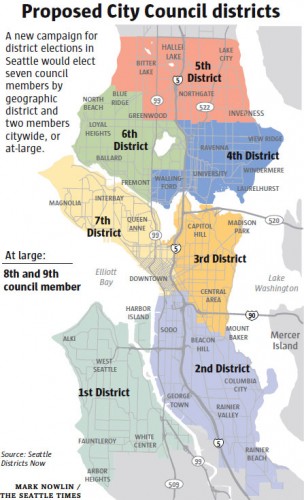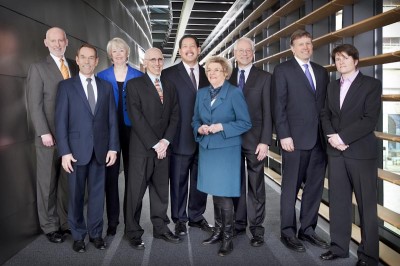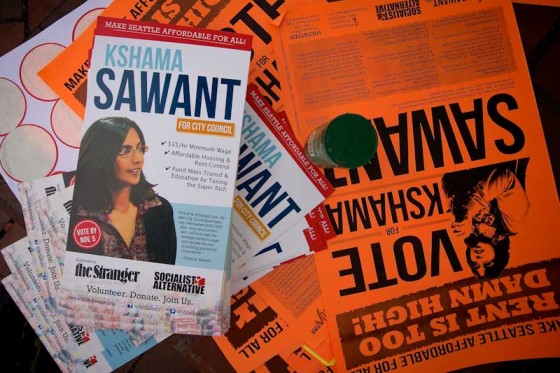With all of the progressive steps our city has taken in the past few years, why does meaningful minority representation still elude us?
Like many progressive Seattleites, I was pleasantly surprised by the news that Kshama Sawant will be replacing Richard Conlin on the city council.
Not only is she an educator, labor activist, and the first socialist candidate to be elected to the city council, but she is also an immigrant from South Asia. Her unexpected comeback victory was yet another warm and fuzzy political moment for this progressive, unapologetic liberal.
But my elation over this one small step made me realize just how far Seattle still has to go in terms of diversity in our political representation.
According to the last census there are over 6.7 million people living in Washington, 650,000 of who live in Seattle proper. In terms of ethnic breakdown it’s one of the more diverse populations in Washington. Roughly 69% of citizens are white, 13% Asian, 8% black, 6% Latino, and the rest bi-racial, Native American, and undeclared. That’s not to mention the roughly 17% of Seattleites who were born in another country.
But what these numbers actually look like on the streets of our city is a different story.
If you are up for a little experiment, catch the #5 bus from Greenwood to Downtown, then transfer to a #7 and ride it to Rainier Beach. Notice who gets on and who gets off where and you will have an accurate portrayal of the way our city self-segregates. The further south you go, the more people of color you will encounter.

While we are currently a city with a clear white majority, there are specific areas where the population of people of color is steadily increasing. Legislative and City Council Districts are theoretically created in such a way as to make each vote count. Lines are drawn and re-drawn to ensure that each neighborhood’s population is accurately represented.
Having lived in various neighborhoods throughout the city, I have seen firsthand how these demographics play out.
In Wallingford, for example, where my best friend and I shared a duplex, we constituted 2/3 of the population of people of color on our block. With three whole black people, we were notably one of the most diverse blocks in the Wallyhood.
When I moved south to Beacon Hill I was still one of the few black people in my neighborhood. The big difference was that in Wallingford white people formed a super majority, whereas in Beacon Hill there were larger Asian and Latino populations than any other ethnicity.
Two years ago I bought a house in Rainier Beach. To the left my neighbors are Vietnamese, to the right, Mexican, across the street Cambodian, East African, and African American. I live in the 98118. Within my 6 mile radius over 59 different languages are spoken.
Yet throughout last year’s presidential elections and even our recent local elections, I did not receive a single leaflet about a political issue or candidate in English or any of the other 59 languages spoken here. No precinct officer knocked on my door, like when I lived in Greenwood. There were no PSAs to inform me about where caucuses might be taking place or any other way in which I might take part in our local political processes.
Did the politicians miss us on accident? Did they see the crime statistics on my zip code and hesitate to send canvassers? Are there too many first generation immigrants in my community? Do they think there aren’t enough citizens to bother campaigning here?
Or is it more that regardless of whether we are U.S. or foreign-born people of color, our votes don’t really count in Seattle?

Moreover, even in neighborhoods where I was more politically engaged, I still didn’t find out about re-districting until I started working for a local union. There the political director was committed to advocating for a re-drafting process that would shift district lines so that people of color would have more political sway.
When I think of voting rights, I think of states like Mississippi and Florida. I think about poll taxes, literacy tests, and the “grandfather clause” — the law that said if your grandfather didn’t vote then neither could you. I think about faulty voting booths and all the ways past and present white men in power have conspired to keep that power by preventing women and people of color from voting.
I can’t help but wonder if redistricting is just another, less direct, version of this vote tampering. Redistricting did create a majority-minority congressional district stretching south from Seattle to Federal Way. But unions and community groups had actually been pushing for two districts to be majority people of color. And that one minority district that was created is still not represented by a person of color.
Following the 2012 redistricting, the Washington State Legislature actually became less diverse, bucking a national trend and a big increase in the minority population of the state.
And the new city council districts, which will take effect in 2015, have the same problems with minority representation.
I’m no an expert on how the re-districting process works. I watched the streaming video of the commissioners’ meetings and felt like I needed a translator and some strong coffee to wade through all the legalese and map references. Ultimately I am unclear how my vote is impacted.
But when I look at the pictures of candidates in my voter’s pamphlet, or at the video of the all-white redistricting commission, I can’t help but wonder — in 2043, when people of color become a majority in our country, and Seattle likely echoes this demographic shift, will our government still look the same?
How will the lines be drawn then?



Great article!
Good piece, and there are definitely racial issues in Seattle… more than many people would like to think. I’d like to note, though, that not all of us minorities vote as a bloc! I’m glad to see a woman of color on the council, but I’m not sure that she will *necessarily* represent me better than the white man she replaced.
In terms of outreach, or acknowledgment of voters, nobody knocked on my door either. I received a few mailings right before the election. That’s it. I live in W Seattle on the border with White Center. If it matters, I’m white. The answers might lie with campaign consultants hired for direct mailings. They’re paid to sway votes. I’d like to know what they know.